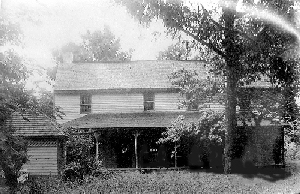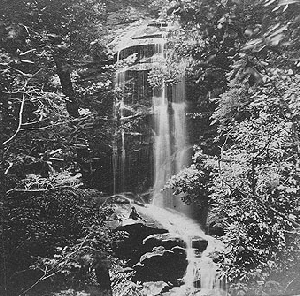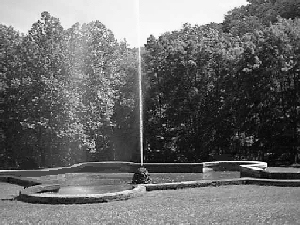

Old Fort, North Carolina's place in Western North Carolina history is unique. This could be due to its geographic location at the foot of the Blue Ridge and being near the head of the Catawba River close to the Continental Divide. Although hundreds of years of human habitation existed in this area prior to the recorded period, my information will only relate to that which is a matter of record.
It would be virtually impossible to recount the history of Western North Carolina and not mention some of the brave and courageous (not to mention colorful) pioneer settlers of the time; among whom were some of our Burgin and Lytle ancestors. To do so, could be likened to that of discussing the production of honey and omitting the "worker" bee.
There is evidence that in 1566, Juan Pardo, a Spanish adventurer accompanied by thirty men, came to what is now Western North Carolina. He traveled from the South Carolina coast and his purpose was supposedly to acquire territory for Spain, but in reality, he had hoped to find precious metals.
When Juan Pardo had reached the headwaters of the Catawba River, he had his men build a log blockhouse. No doubt, he was intimidated by the formidable range of the Blue Ridge and hesitated before venturing into the home of the Cherokee Nation.
The next year, however, he took about half of his men and went west as far as to what is now Franklin, NC. From there, he started back to the South Carolina coast and was never heard of again. No one knows what became of his men, or what happened to the small fort they left behind.
Another hundred years passed before anything was again heard of this region. In 1690 James Moore, who was Secretary of the Colony of South Carolina, explored these hills and wrote that Indians told him a few Spaniards were mining about twenty miles away.
More and more settlers continued to come up the Catawba Valley. In 1763, the British and the Cherokee nation made a treaty agreeing that the British would settle no farther west of Old Fort than the crest of the Blue Ridge mountains.
Around 1770 Samuel Davidson purchased a boundary of land, which included the present site of Old Fort, consisting of 640 acres or one square mile. A stockade was raised upon a portion of this land, but by whom and for what specific purpose is still debated by some historians.
Some say Davidson built it for the use of the white settlers; others report that Captain Hugh Waddell constructed it with Colonial Militia left “to guard and range the country while General Rutherford led with an expedition against the Cherokee.”
For 20 years, from 1756 to 1776, the settlement around the stockade was the western- most outpost of Colonial Civilization. The State of North Carolina then extended to the Mississippi River. It was during this period the first appearance of Benjamin Burgin on any North Carolina records was noted.
On November 18, 1772, a Marriage Bond for Benjamin Burgin's marriage to Leah Mann, is posted. It is this Benjamin Burgin descendants refer to as "Pioneer" Ben and his son Benjamin, Jr., as "Major" Ben.

Pioneer Ben's Old Homeplace - Destroyed by fire in 1929 Ben had worked as a blacksmith and carpenter in Maryland, but in North Carolina, he would operate a tannery. They used the tannin from the bark of the abundant local trees turning the equally abundant animal skins into leather, a commodity much needed on the frontier.
In the Spring of 1774, Samuel Davidson decided to move across the Blue Ridge and build a cabin near what is now Azalea. This was in violation of the treaty mentioned above. The indians would later take a bell from Davidson's grazing horse and use it to lure him to his death. His wife, baby, and servant girl fled back across the Continental Divide, down the mountain to Davidson’s Fort and safety.
Pioneer Ben was part of the retaliatory raid that returned to find, and bury, Davidson's scalped body where he had fallen. They overtook the indians where they were camping on the trail in present Buncombe County and tradition is that the entire party of indians were either slain or fled to safety in the deep woods.
The extent of Pioneer Ben's participation in the Revolutionary War may never be known. Many of his descendants feel that Ben was one of the "Over-the-Mountain-Men" who marched to defeat the British at the battle of King's Mountain in 1780. There is no hard evidence or records to support this claim, because most of these records were destroyed when the courthouse was burned by Union soldiers in 1865.
In 1788 Ben was serving as Justice of the Peace, the following year he was a Deputy Sheriff of Burke County (now McDowell County). During the next decade he frequently would be referred to with the sobriquet "Esquire", which was used only for community leaders. Benjamin Burgin was again appointed a Justice of Peace in 1794, a position much more important than it is today. He was actually one of the judges of the county court, The Court of Pleas and Quarter Sessions.
In October, 1796 court session Ben Burgin and Joseph Young were appointed "judges of the upper election for elector". Therefore, Ben participated in the selection of members of the electoral college which elected the second president of the United States, John Adams.
Benjamin Burgin died April 5, 1823 and Leah Burgin died August 9, 1837. Based on the information in the Ben Burgin family Bible, he and Leah had eleven children.
In 1822, Merritt Burgin son of Pioneer Ben, gets elected to the North Carolina House of Representatives. Merritt had a distinguished career as a farmer, surveyor, military officer, jurist and legislator. He took an active interest in civic and political affairs and later served as State Senator 1827-1830, becoming the first member of the Burgin family to serve in both houses of the state legislature. Merritt did all this without the flamboyance or eccentricities of his brother Major Ben.
In 1824, Alney Burgin, son of Pioneer Ben, is also elected to the North Carolina House of representatives. He served 1824-25 and again from 1830-34. Like his brother Merritt, he also served as a State Senator 1842-43. Alney Burgin was considered to be a man of powerful influence in the community and government. His close friends included Davy Crockett, famous Tennessee pioneer and politician who died at The Alamo, and North Carolina Senator Samuel P Carson. Alney served as Carson's second at the infamous Vance-Carson Duel. Vance was killed and Carson moved to Texas to become the first Secretary of State of the Republic of Texas.
In 1842, McDowell County is formed from Rutherford and Burke Counties; and in 1843, James Burgin, son of Jesse Burgin, was presiding Justice when McDowell County Court held its first session (Court of Pleas and Quarter Sessions). At this time James was still living on "Byers Fork of Crooked Creek". Many of James' descendants still live on Crooked Creek. James married Leah Burgin, daughter of Pioneer Ben.
In 1844, Major Benjamin Burgin, son of Pioneer Ben, gets elected as State Rep. and serves in 1844 & 1845. Like the other members of his family, Ben was very active in political and civic affairs. He served several times as Justice of Peace and Clerk of the Court. He was also considered to be a man of indomitable faith, admired by many and questioned by others. How staunch a man was he? Ben refused to drink with Governor Graham while serving as a member of the legislature. He was 96 years old when he was killed by one of his favorite horses.
I feel that it is important to mention at this juncture, that the four Burgin men just described, all served their country during the War of 1812 and each of them was a comissioned officer. Merritt would later reach the rank of Colonel in the 8th North Carolina Militia Regiment in 1815. Alney was referred to as "General Alney", but there are no military records indicating this rank. James was a Lieutenant, and of course, "Major Ben" attained the rank of Major.
Circa 1855-56, Logan Burgin, son of Major Ben was named by the Board of Directors of the Western North Carolina Railroad as a member of the McDowell County Committee to set up books and receive stock in the W.N.C.R.R. for the purpose of building the railroad in McDowell County.
By 1860, the Western Carolina Railway has finally reached Old Fort. The winding circuitous route of the track through the western hills to the top of the mountains at Ridgecrest was necessary due to the lack of earthmoving machinery and by the need to keep the grade easy enough for a steam engine to pull a train of heavily loaded cars.
McDowell County was scarcely 20 years old and had just begun to function in the family of North Carolina counties when the Civil War intervened. Records show that at least 22 of Pioneer Ben's descendants or descendant's spouses served in this war. Captain Thomas Young Lytle (husband of Elizabeth Ann Burgin) who lived on Crooked Creek, was credited with having fired the first shot of the War Between the States.
During the ensuing four years of conflict (1861-1865) the economy of McDowell County, as in other counties in the state, is severely taxed. At the end of the war her people were in dire straits. The County never fully recovered from paralyzing lethargy following the Civil War. There was not a home in Old Fort that had not been adversely affected.
In 1871 the 2,200-acre plantation of G.S.F. Davidson sold for thirty thousand dollars to the Catawba Vale Land Association, two years after the Western North Carolina railroad had reached Old Fort. “The Town of Catawba Vale is quite large on paper, but is small on the ground,” writes one of the speculators in a letter to a friend up north.
In 1872, the town was chartered by the General Assembly. The dream of a fast growing village is shattered, however, when the work on the railroad ceases because money had been embezzled. The sale of land stopped; no new settlers arrived; and the railroad shops were located in Spencer instead of “Catawba Vale. In 1873, the name of “Old Fort” was given to the town by the legislature and speculators who had hoped to have held office left town.
In 1873, Alfred Morgan, Agent for the railroad writes, "Old Fort, the present terminus for the Western North Carolina Railroad, derives its name from an old fort which was built to protect the early settlers from the indians. It is the most romantic and beautiful spot, being just at the entrance of the mountains proper.
The Upper and Lower Catawba Falls are within a few miles of this place. Point Tunnel is about a mile from Old Fort on the road to Ashville, and is the only one of a series that have been begun on this road.

Upper Catawba Falls - Picture by Rufus Morgan From here, can also be had, a distant view of the Black Mountains, celebrated as being the highest in the United States, east of the Missippi River"
From 1876 to 1879, Henry’s Station, three miles west of Old Fort, is the terminal from which passengers are transported by stagecoach, and freight, by wagon to and from Asheville.
In March 1879, the railroad enters Buncombe County through the Swannanoa Tunnel and reaches Asheville in 1880. Seven hand-dug tunnels, nine miles of track, and eleven years later, the new railroad has finally reached Asheville.
Three hundred lives were lost building the Western Carolina Railroad; nonetheless, the coming of the railroad means economic, intellectual, and industrial opportunities for the "mountain people". The busy little town of Old Fort becomes the home of a resort hotel and a manmade geyser, a tourist attraction powered by a nearby spring.
During the Winter of 1887, Joseph Benjamin Burgin, son of Alney, organized the "Texas train". Joe Ben (J.B.) who worked for the Western Carolina Railroad for many years - made the arrangements for a group of twenty townsfolk along with their children, to make the trip to the "new land of opportunity" via rail.
1900 - 1902, William M. Burgin, grandson of Merritt, is the sheriff of McDowell County.
The hotel was destroyed by fire in 1903, but in 1911 a wealthy New Yorker saved the geyser.

The Col. A.B. Andrews Geyser is actually a fountain He bought the land around it, moved it across the creek, redesigned it and named it in honor of Col. A.B. Andrews, engineer and the first president of the Western North Carolina Railroad.
Today, the geyser belongs to the town. There is a generous amount of shade and several tables are provided for picnics.
In 1904, The Union Tanning Company built a tanning and extract plant in Old Fort and for many years, the huge industry dominated the economy of Old Fort. Men not actually employed in the processing of leather made a living cutting and hauling “acid-wood and tan bark” A flume filled with rapidly running water floated wood from the headwaters of Curtis Creek to the tannery wood yard. A narrow gauge railroad ran from the Catawba Falls area to the wood yard also. Southern Railway cars loaded with South American raw hides “with flesh still on them” came to the sidings.
The smell of the hides and the stench of the processing leather fouled the air in every direction for several miles. Travelers vowed they could tell when they were nearing Old Fort, but the citizens were grateful for the steady payroll even though the working hours were from six to six. The wooden building of the United Leather Company was struck by lightning during a summer storm in 1930. It burned and was never rebuilt.
Circa 1905, Mary Greenlee Burgin, g-grand daughter of Merritt Burgin, begins a teaching career that that spans 50 years in a one-room school building. She taught the first grade at Old Fort for 39 years. Teaching was her life; she remained unmarried and never had children of her own. "Miss Mary" was loved and respected by all.
On the morning of July 14th 1916, A tropical storm passed over Charleston, SC., causing some local damage, and moving northwestward, expended its full force on all the water- sheds in western North Carolina. Torrential rain from the storm of July 5th and 6th had already saturated the soil and filled the stream banks full. All previous 24-hour records of rainfall in the United States were exceeded.
The run off from the saturated soil was very rapid, streams rose high above all previous flood records; resulting in the deaths of about eighty people and in property damage estimated by the U.S. Weather Bureau at about $22,000,000. The Southern Railway Company's losses were said to have been well over $1,250,000.
In 1927, Old Fort High School is consolidated with other smaller schools in the area and transportation via school bus is available for the first time. The school burned in 1934 and some children temporarily attended school in down-town churches. A new high school was completed in 1936.
Old Fort was the site of many of skirmishes between the early settlers and the native Americans. Much of the fighting actually took place on the banks of Mill Creek, which runs through the center of town. To symbolize the peace agreement between the two, a landmark was erected at the depot in the 1930's.
Standing in front of the Old Fort Depot is a 30-foot tall arrowhead, hand chiseled in granite.
The landmark was unveiled to a crowd of more than 6,000 people in the 1930s.
It was to serve as a symbol of the peace achieved in the previous century between pioneers and the Indians.
In 1947, Old Fort Finishing Company was built on the site where the Union Tanning Company once stood. Old Fort Finishing was huge --16 acres under one roof! At their peak, they employed 1,000 people and were processing up to 2 million yards of textile fabrics daily. Owned by United Merchants and Manufacturing Company, the plant soon became a vital part of Old Fort's economy.In the early 1980's, the booming Textile Industry, began to falter. Foreign imports and the two-price cotton system began to take their toll and by 1984, sixty-one textile plants in North and South Carolina had shut down. The industry overall had shrunk by 19,500 workers.
On July 31, 1984, Old Fort Finishing halted production, thus eliminating the jobs of the remaining 492 employees and sending shock waves through this small town. A harsh silence now hangs over the huge cavernous plant that operated over a five decade period. (the machinery has since been removed) Needless to say, its closure had a disaterous effect on the town's economy.
Not with-standing the aforesaid adversities; travelers have always found a welcoming and hospitable stop in this small historic community, for over two centuries. Old Fort is located in McDowell County and had an estimated population of 826 on July 1, 1998. This was an increase of 94 over the 1990 census.
McDowell County population: 35,681 (1990); 42,151 (2000)
Land area 442 square miles
County seat: Marion
Source: Old Fort Chamber of Comm., "Echoes in the Mist" Peggy Silvers, "Burgins Back to Devon" Ramond Burgin, Carter & Lovyne Burgin, www.mcdowellcounty.org, Bill Peterson (Washington Post) & Binkie Adams.